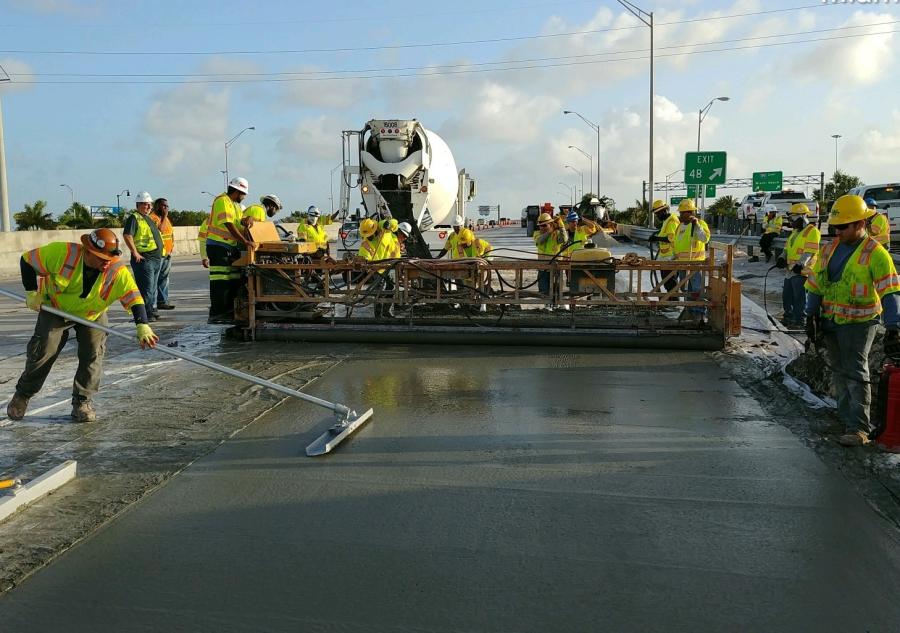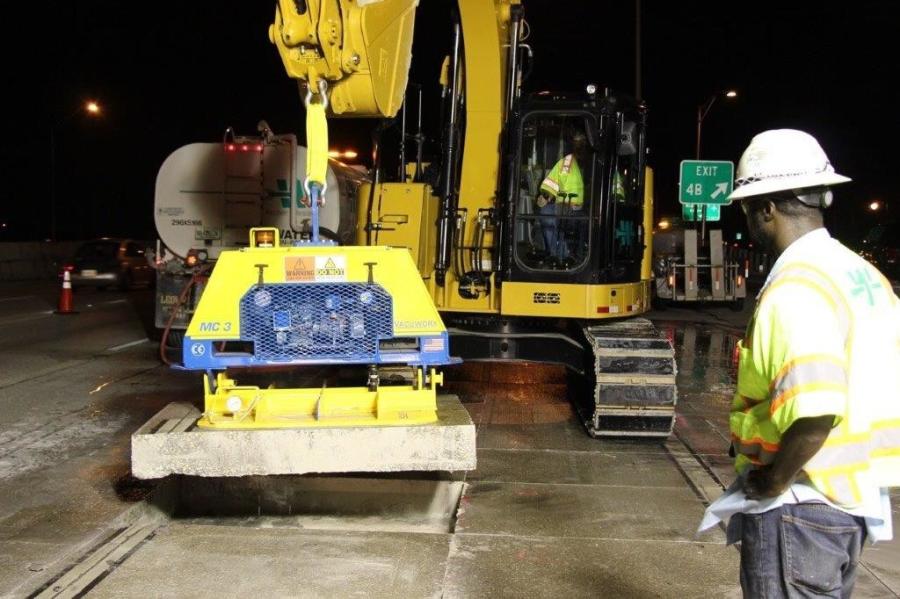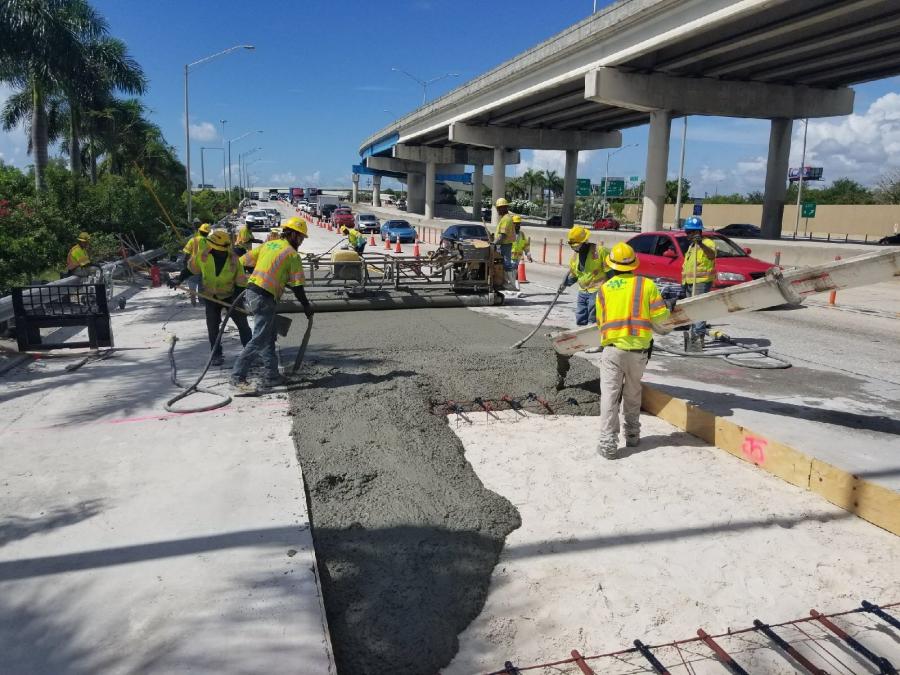The project has an average of more than 150 workers per night.
Started in February 2017, Archer Western Construction LLC is currently in its second year of work on the Florida Department of Transportation's (FDOT) $89.5 million multi-year project to enhance 6.285-mi. of highway (six lanes in each direction) along SR 9A/I-95 from NW 29 Street to NW 131 Street in Miami-Dade County.
The project, funded both federally and by the state, is expected to be completed in summer 2020.
 The work will replace the concrete road surface on northbound and southbound SR 9A/I-95 from NW 29 Street to NW 79 Street; rehabilitate bridge joints; enhance drainage along the project corridor; asphalt pave ramps at NW 79 Street and NW 69 Street; install new signage, lighting, lane striping and intelligent transportation systems such as cameras, vehicle sensors and overhead electronic message boards; and construct five emergency stopping sites (ESS) in the median on SR 9A/I-95 between NW 62 Street and NW 131 Street. There will be three ESS sites in the northbound direction and two in the southern direction. The ESS sites are expected to be open late May 2018 and the concrete replacement is expected to be completed in the summer of 2020.
The work will replace the concrete road surface on northbound and southbound SR 9A/I-95 from NW 29 Street to NW 79 Street; rehabilitate bridge joints; enhance drainage along the project corridor; asphalt pave ramps at NW 79 Street and NW 69 Street; install new signage, lighting, lane striping and intelligent transportation systems such as cameras, vehicle sensors and overhead electronic message boards; and construct five emergency stopping sites (ESS) in the median on SR 9A/I-95 between NW 62 Street and NW 131 Street. There will be three ESS sites in the northbound direction and two in the southern direction. The ESS sites are expected to be open late May 2018 and the concrete replacement is expected to be completed in the summer of 2020.
“The project will enhance the rideability of I-95 from NW 29 Street and NW 131st Street,” said Moe Mabrouk P.E. CEI senior project engineer with Calvin, Giordano & Associates Inc. “It will provide drivers and first responders with more room to pull off the express lanes for emergency stops or enforcement activities, which will decrease traffic back up in the express lanes during emergency situations.”
I-95 in Miami-Dade County was constructed in 1963 and since then has undergone several widening and pavement rehabilitation projects.
The current project has been in the planning stage since 2015. The ESS sites project is part of a series of safety initiatives along I-95 Express Lanes that include installing sturdier, more durable express lane markers that are spaced closer together to reduce lane diving. The department has plans to improve other sections of I-95 over the next five years.
On an average day, approximately 254,500 cars and trucks use this section of highway.
FDOT provided concept plans in the proposal prepared by Keith and Schnars, and final design for the roadwork was prepared by GAI Consultants, the EOR for the design-build firm.
“One of the major challenges is to develop an innovative concrete mix design that will reach minimum compressive strength of 2,200 psi within the allowable lane closure times to not impact morning rush hour commute,” said Mabrouk. “The existing concrete thickness is approximately 9 inches In order to improve the life span, the new pavement thickness has been increased to 10.5 inches. The design change considers increased usage and heavier loads.
“A total of 10 WiFi/Bluetooth PCMSs have been deployed as part of a traffic divergence plan with the goal of providing advanced notice to motorists of ongoing closures so they can seek alternate routes,” Mabrouk added. “The messages of the WiFi PCMSs devices are integrated and remotely operated by SunGuide Transportation Management Center. In Florida, the average age of a properly designed and constructed concrete pavement prior to first rehabilitation ranges from 25 to 28 years, and many have lasted longer.”
The traffic management plan will require traffic shifts and temporary lane closures during non-peak hours at night and during the day with detours as the general contractor performs work along the corridor and ramps.
 “In order to minimize impacts to the traveling public, lane closures are limited to nighttime hours and weekends,” said Oscar Gonzalez, the project community outreach specialist. “The project team is mindful of special events and has suspended or modified closures during events such as Ultra Music Festival, Art Basel, Hurricane Games, Dolphin Games, MLB All-Star Events as well as concerts in venues near the project limits. The contractor has been working closely with local law enforcement agencies to ensure compliance during closures. Additionally, the contractor has installed speed feedback signs to notify drivers of their traveling speeds and encourage them to follow posted speed limits. Access to businesses are maintained at all times. Materials and equipment are brought in through the lane closures at key points through the Golden Glades Park and Ride and closed ramps.”
“In order to minimize impacts to the traveling public, lane closures are limited to nighttime hours and weekends,” said Oscar Gonzalez, the project community outreach specialist. “The project team is mindful of special events and has suspended or modified closures during events such as Ultra Music Festival, Art Basel, Hurricane Games, Dolphin Games, MLB All-Star Events as well as concerts in venues near the project limits. The contractor has been working closely with local law enforcement agencies to ensure compliance during closures. Additionally, the contractor has installed speed feedback signs to notify drivers of their traveling speeds and encourage them to follow posted speed limits. Access to businesses are maintained at all times. Materials and equipment are brought in through the lane closures at key points through the Golden Glades Park and Ride and closed ramps.”
So far, Archer Western has completed pavement replacement on NB I-95 Lane 6 and the removals and drainage on all five of the emergency stopping sites. The goals for the 2018 season are to complete and open the emergency stopping sites, start the bridge work, and complete 75 percent of the NB I-95 paving work.
 “The major challenge on this project is working within lane closures at night,” said Nick Fauls, Archer Western's project manager. “The short closure windows leave little room for error when it comes to our concrete paving removals and replacement. All work is at night and all materials and equipment are hauled in and out of the site each night. We have encountered no utility related issues on this project so far. We work on multiple locations within our work site on a nightly basis. We typically have over 150 workers on average working nightly to complete the project. Communication with FDOT has been key throughout the project to resolve issues quickly and efficiently.”
“The major challenge on this project is working within lane closures at night,” said Nick Fauls, Archer Western's project manager. “The short closure windows leave little room for error when it comes to our concrete paving removals and replacement. All work is at night and all materials and equipment are hauled in and out of the site each night. We have encountered no utility related issues on this project so far. We work on multiple locations within our work site on a nightly basis. We typically have over 150 workers on average working nightly to complete the project. Communication with FDOT has been key throughout the project to resolve issues quickly and efficiently.”
“The roadwork is progressing well,” Fauls added. “There have been no repairs to the existing roadbase to date. Good progress has been made on the rehabilitation of the bridge joints. Work on the emergency stopping sites has been priority to date. With this work ending, we will ramp up the mainline paving work.”
“The contractor has proven that he can achieve good concrete production day in and day out,” said Bernnon Artola, CEI project administrator of Calvin, Giordano & Associates Inc. “We expect the contractor to continue this trend as the project focus shifts to the paving work.”
The drainage work took place at the emergency stopping sites. This involved removal of the existing median drainage system and inlets and installation of a new trunk line with median barrier inlets.
“Working between two temporary barrier walls with limited space has presented challenges with the drainage installation,” said Fauls.
The subcontractors on this project include: Traffic Management Systems, Ranger, Traffic Control Products, Shelby Erectors, Bob's Barricades, Amroad, Vacvision and Badger Daylighting.
“We discuss upcoming schedules daily with our subcontractors,” said Fauls. “We are utilizing temporary barrier wall where feasible and truck mounted attenuators to protect the workers from motorists. Off-duty police officers are also placed at strategic locations throughout the project to alert motorists of the workers.”
The work will see the removal and reconstruction of 284,000 sq. yds. of concrete pavement as well as the sawing and sealing of 408,000 linear ft. of concrete joints.
“Our concrete pavement production rate is 60 cubic yards per night per-crew,” said Fauls. “We are recycling all concrete and soils removed from the project. Archer Western, as a member of the Walsh Group, has a commitment to be a green builder.”
 Archer Western is using a Cat 325 and a Cat 315 excavator, Takeuchi mini-excavators, Cat D5 dozers, a Cat 292 skid steer, Volvo L90 and L120 loaders, an Allen triple-tube roller screed, Hamm double-drum rollers, Mack dump trucks and McNeilus concrete mixer trucks.
Archer Western is using a Cat 325 and a Cat 315 excavator, Takeuchi mini-excavators, Cat D5 dozers, a Cat 292 skid steer, Volvo L90 and L120 loaders, an Allen triple-tube roller screed, Hamm double-drum rollers, Mack dump trucks and McNeilus concrete mixer trucks.
“Trucking is a big part of the project as each morning the lanes of the interstate must all be open to traffic,” said Fauls. “We have a full-time mechanic who repairs any wear and tear items during the day so they will be prepared for the night shift.”
Archer Western purchases and rents equipment from dealerships such as Flagler, Kelly Tractor, United Rentals and Herc Rentals.
“The dealerships are a great help to the project,” said Fauls. “They are available at any time of the day to provide service and equipment should we have any breakdowns during the night shift.”
CEG
Irwin Rapoport
A journalist who started his career at a weekly community newspaper, Irwin Rapoport has written about construction and architecture for more than 15 years, as well as a variety of other subjects, such as recycling, environmental issues, business supply chains, property development, pulp and paper, agriculture, solar power and energy, and education. Getting the story right and illustrating the hard work and professionalism that goes into completing road, bridge, and building projects is important to him. A key element of his construction articles is to provide readers with an opportunity to see how general contractors and departments of transportation complete their projects and address challenges so that lessons learned can be shared with a wider audience.
Rapoport has a BA in History and a Minor in Political Science from Concordia University. His hobbies include hiking, birding, cycling, reading, going to concerts and plays, hanging out with friends and family, and architecture. He is keen to one day write an MA thesis on military and economic planning by the Great Powers prior to the start of the First World War.
Read more from Irwin Rapoport here.
Today's top stories










 The work will replace the concrete road surface on northbound and southbound SR 9A/I-95 from NW 29 Street to NW 79 Street; rehabilitate bridge joints; enhance drainage along the project corridor; asphalt pave ramps at NW 79 Street and NW 69 Street; install new signage, lighting, lane striping and intelligent transportation systems such as cameras, vehicle sensors and overhead electronic message boards; and construct five emergency stopping sites (ESS) in the median on SR 9A/I-95 between NW 62 Street and NW 131 Street. There will be three ESS sites in the northbound direction and two in the southern direction. The ESS sites are expected to be open late May 2018 and the concrete replacement is expected to be completed in the summer of 2020.
The work will replace the concrete road surface on northbound and southbound SR 9A/I-95 from NW 29 Street to NW 79 Street; rehabilitate bridge joints; enhance drainage along the project corridor; asphalt pave ramps at NW 79 Street and NW 69 Street; install new signage, lighting, lane striping and intelligent transportation systems such as cameras, vehicle sensors and overhead electronic message boards; and construct five emergency stopping sites (ESS) in the median on SR 9A/I-95 between NW 62 Street and NW 131 Street. There will be three ESS sites in the northbound direction and two in the southern direction. The ESS sites are expected to be open late May 2018 and the concrete replacement is expected to be completed in the summer of 2020. “In order to minimize impacts to the traveling public, lane closures are limited to nighttime hours and weekends,” said Oscar Gonzalez, the project community outreach specialist. “The project team is mindful of special events and has suspended or modified closures during events such as Ultra Music Festival, Art Basel, Hurricane Games, Dolphin Games, MLB All-Star Events as well as concerts in venues near the project limits. The contractor has been working closely with local law enforcement agencies to ensure compliance during closures. Additionally, the contractor has installed speed feedback signs to notify drivers of their traveling speeds and encourage them to follow posted speed limits. Access to businesses are maintained at all times. Materials and equipment are brought in through the lane closures at key points through the Golden Glades Park and Ride and closed ramps.”
“In order to minimize impacts to the traveling public, lane closures are limited to nighttime hours and weekends,” said Oscar Gonzalez, the project community outreach specialist. “The project team is mindful of special events and has suspended or modified closures during events such as Ultra Music Festival, Art Basel, Hurricane Games, Dolphin Games, MLB All-Star Events as well as concerts in venues near the project limits. The contractor has been working closely with local law enforcement agencies to ensure compliance during closures. Additionally, the contractor has installed speed feedback signs to notify drivers of their traveling speeds and encourage them to follow posted speed limits. Access to businesses are maintained at all times. Materials and equipment are brought in through the lane closures at key points through the Golden Glades Park and Ride and closed ramps.” “The major challenge on this project is working within lane closures at night,” said Nick Fauls, Archer Western's project manager. “The short closure windows leave little room for error when it comes to our concrete paving removals and replacement. All work is at night and all materials and equipment are hauled in and out of the site each night. We have encountered no utility related issues on this project so far. We work on multiple locations within our work site on a nightly basis. We typically have over 150 workers on average working nightly to complete the project. Communication with FDOT has been key throughout the project to resolve issues quickly and efficiently.”
“The major challenge on this project is working within lane closures at night,” said Nick Fauls, Archer Western's project manager. “The short closure windows leave little room for error when it comes to our concrete paving removals and replacement. All work is at night and all materials and equipment are hauled in and out of the site each night. We have encountered no utility related issues on this project so far. We work on multiple locations within our work site on a nightly basis. We typically have over 150 workers on average working nightly to complete the project. Communication with FDOT has been key throughout the project to resolve issues quickly and efficiently.” Archer Western is using a Cat 325 and a Cat 315 excavator, Takeuchi mini-excavators, Cat D5 dozers, a Cat 292 skid steer, Volvo L90 and L120 loaders, an Allen triple-tube roller screed, Hamm double-drum rollers, Mack dump trucks and McNeilus concrete mixer trucks.
Archer Western is using a Cat 325 and a Cat 315 excavator, Takeuchi mini-excavators, Cat D5 dozers, a Cat 292 skid steer, Volvo L90 and L120 loaders, an Allen triple-tube roller screed, Hamm double-drum rollers, Mack dump trucks and McNeilus concrete mixer trucks.






